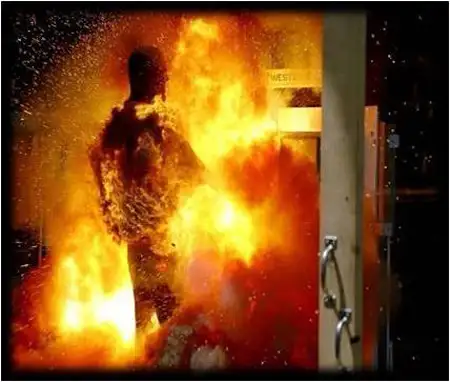Arc Flash Temperature Explained

NFPA 70e Training - Arc Flash
Our customized live online or in‑person group training can be delivered to your staff at your location.

- Live Online
- 6 hours Instructor-led
- Group Training Available
Download Our OSHA 3875 Fact Sheet – Electrical PPE for Power Industry Workers

- Follow rules for rubber gloves, arc-rated PPE, and inspection procedures
- Learn employer obligations for testing, certification, and training
- Protect workers from arc flash and electrical shock injuries
Arc flash temperature can exceed 35,000°F, releasing intense heat, plasma, and pressure waves. These extreme electrical fault conditions cause severe burns, ignite clothing, and damage equipment, highlighting the critical need for PPE and hazard analysis.
What is Arc Flash Temperature?
Arc flash temperature refers to the extreme heat generated during an electrical arc fault, often hotter than the surface of the sun. This intense energy creates severe hazards to workers and equipment.
✅ Reaches up to 35,000°F in arc conditions
✅ Causes thermal burns, ignition, and equipment failure
✅ Requires PPE, shock protection, and NFPA 70E compliance
Request a Free Training Quotation
An arc flash is the light and heat released when uncontrolled electrical energy rapidly discharges within an electrical system, creating temperatures of tens of thousands of degrees Fahrenheit. This intense event is often accompanied by an arc blast, a violent pressure wave that adds to the destructive force of the electrical explosion. The combination of heat, pressure, and molten metal can devastate equipment and cause life-threatening injuries to anyone nearby. To withstand these conditions, workers must rely on properly rated personal protective equipment (PPE), which is specifically designed to reduce exposure to extreme heat and flying debris. Understanding arc flash requires more than just knowing temperature; it also involves recognizing the explosive energy release that creates plasma hotter than the sun.
How Hot is an Arc Flash?
An arc flash temperature can range from 2,800°C to over 19,000°C (5,000°F to 35,000°F). By comparison, the sun’s surface temperature is about 5,500°C (9,932°F). Welding arcs may reach 11,000°F, but arc flash can triple that intensity. Staged laboratory tests have measured neck and hand exposures exceeding 437°F, even at a distance of 10 feet, which is well above the human burn threshold. Even at 480 volts, 480v arc flash incidents can generate temperatures that ignite clothing instantly and cause severe burns within seconds.
Sign Up for Electricity Forum’s Arc Flash Newsletter
Stay informed with our FREE Arc Flash Newsletter — get the latest news, breakthrough technologies, and expert insights, delivered straight to your inbox.
Effects of Arc Flash Heat on Materials
The extreme temperature of an electrical explosion vaporizes metals and ignites clothing almost instantly:
-
Copper melts at 1,984°F but vaporizes in arc plasma.
-
Aluminum melts at 1,221°F and is easily liquefied.
-
Steel loses strength rapidly above 1,500°F.
-
Cotton ignites at 752°F, polyester at 842°F, PVC at 736°F.
When vaporized, copper expands 67,000 times its solid volume, and water expands 1,670 times as it turns to steam. These violent transformations generate molten metal spray, pressure waves, and toxic smoke.
Human Exposure and Burn Risk
An electrical explosion can cause second and third-degree burns within fractions of a second. OSHA testing shows that exposed skin at a distance of one to two feet from an arc is beyond survivable thresholds. At greater distances, intense radiant heat still produces serious burns, eye injury from ultraviolet and infrared radiation, and hearing damage as sound levels exceed 140 dB. Protecting against such extremes often requires specialized gear, such as a 40 cal arc flash suit, designed to withstand intense heat and radiant energy.
Measuring Arc Flash Temperature
Researchers measure arc flash temperature using calorimeters, thermocouples, and optical pyrometers during staged experiments. Manikin tests simulate human exposure, while incident energy (cal/cm²) is used in IEEE 1584 studies to indirectly calculate heat impact on workers. These methods confirm the destructive force of electrical explosion plasma and support the development of safe work practices in NFPA 70E Annex K. Severe heat exposure from an arc can result in devastating arc flash burns, often occurring within fractions of a second at distances many workers would assume are safe.
Secondary Hazards from Extreme Heat
Beyond direct burns, arc flash temperature causes:
-
Ignition of clothing, insulation, and nearby combustibles
-
Auto-ignition of oils, solvents, and flammable vapors
-
Release of toxic smoke from burning plastics and wiring jackets
-
Shrapnel injuries from vaporized and re-solidified metals
The extreme plasma temperatures also lead to long-term arc flash injuries, including deep tissue damage, permanent scarring, and life-threatening complications that highlight the need for strict protection.
Related Articles:







